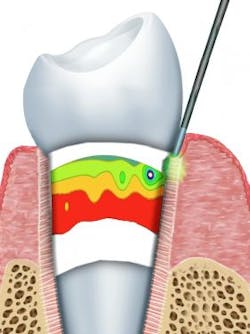Simulations show how dental laser treatments can kill bacterial colonies effectively
Researchers at the New York Institute of Technology (NYIT; New York, NY) have developed computer simulations showing how lasers attack oral bacterial colonies, suggesting that benefits of using lasers in oral debridement include killing bacteria and promoting better dental health.
Related: Dentists without drills? How light-based tools are changing dentistry
In their study, the researchers show the results of simulations depicting various laser wavelengths aimed at virtual bacterial colonies buried in gum tissue. In humans, actual bacterial colonies can cause gingivitis (gum inflammation), which can develop into periodontal disease—a more serious infection that breaks down the bones and tissues that support teeth.
Study co-author Lou Reinisch, Ph.D., associate provost for academic affairs at NYIT, is an expert in laser surgery and an associate editor with the journal Lasers in Surgery and Medicine. He created mathematical models based on optical characteristics of gum tissues and bacteria, and then produced simulations of three different types of lasers commonly used in dentistry. He was able to simulate effects on two types of bacterial colonies of various sizes and depths within the gum models.
"One of the questions we asked is how deep could the bacteria be and still be affected by the laser light," Reinisch says. The simulations indicate that 810 nm diode lasers, when set to short pulses and moderate energy levels, can kill bacteria buried 3 mm deep in the soft tissue of the gums. The 1064 nm Nd:YAG laser is also effective with similar penetration depth. Both lasers spare the healthy tissue, with the simulations showing minimal heating of the surrounding tissue. Minimizing the thermal damage leads to faster healing, he says, adding that their findings are important because it opens up the possibility of tweaking the wavelength, power, and pulse duration to be the most effective for killing bacteria.
The study's methodology of simulating how laser light interacts with tissue has implications beyond dentistry. Physicians and surgeons use lasers in various treatments, including vocal cord procedures and dermatological treatments, including those for toenail fungus.
Guided by the results presented in this study, both Reinisch and co-author David Harris, Ph.D., director of Bio-Medical Consultants, expect that clinical trials will be designed to validate their findings.
Full details of the work appear in the journal Lasers in Surgery and Medicine; for more information, please visit http://dx.doi.org/10.1002/lsm.22568.

